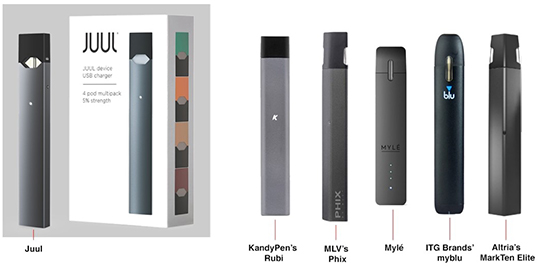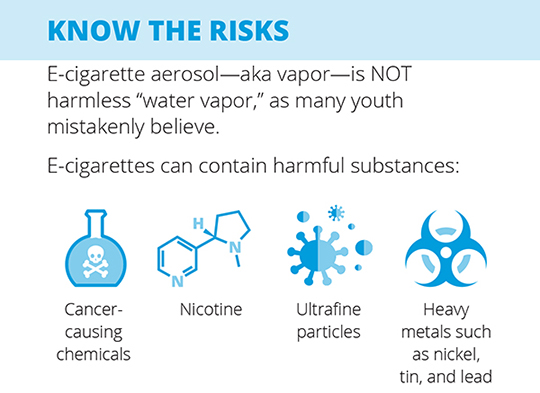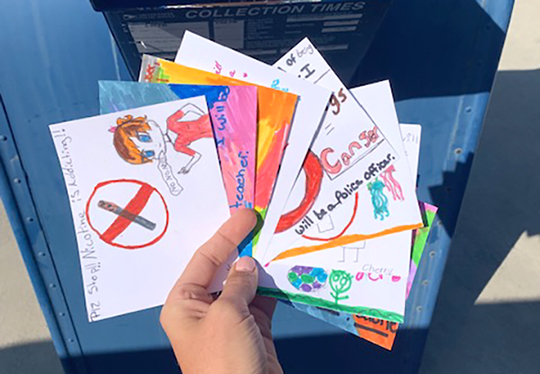News and Events
Youth Vaping Has Been Declared an Epidemic
May 1, 2019
The federal government declared youth vaping, or e-cigarette use, a nationwide epidemic. In light of these concerns and the misinformation surrounding this topic, the Tobacco Free Partnership of DeSoto County and DeSoto SWAT Youth are working hard to educate parents, educators, youth, and community partners on what they need to know about vaping and youth.
Over the past several months, the Tobacco Free Partnership of DeSoto County has worked very closely with the DeSoto County School District. What started as a meeting between the TPS and Principal to discuss a quick intervention on campus, quickly led to training staff, raising awareness among the youth, and revisiting the county’s tobacco policy as a whole.

Our first plan of action was to train the teachers and make them aware of what to look for in the new, sleek devices. Members of the TFP held a training for DHS staff where they informed them on the harms of ENDS as well as examples of the many devices. This was an eye-opening experience for staff - many comments were made about how they saw those items in plain sight all the time and had no idea it was an electronic device.
The ENDS intervention was taken a step further when TFP members held a youth assembly for each graduating class in the high school gym. Youth were informed on the ingredients in ENDS devices, how they are targeted by Big Tobacco, and encouraged not to be a “lab rat”. A student that recently had a bad reaction to vaping shared her story (via video tape) with the entire student body as well. The students were very receptive to the information.
After the assembly, TFP Members met with DHS Dean of Students to discuss ways to strengthen the County’s tobacco policy. The TFP provided the County with 50 + signs last year, including ENDS, to help rely their policy, and we are now looking at strengthening the handbook guidelines, incorporating some type of citation and informative “in school suspension” for students when caught with an ENDS device.
The most popular e-cigarette brand is JUUL(1,2), a device shaped like a USB drive that is available in a variety of flavors and easy to conceal. In fact, youth are using JUUL devices inside school bathrooms and classrooms (3,4,5).

Here are the facts:
- Youth vaping has increased dramatically across the country and in Florida. In 2018, about 25% of Florida high school students reported current use of electronic vaping – a 58% increase compared to 2017 (6).
- Youth are vaping at much higher rates compared to adults. One in four Florida high school students are vaping (7). Only about 4% of Florida adults are vaping (8).
- The long-term health effects of e-cigarettes are still unknown. E-cigarette devices heat a liquid – usually containing nicotine, flavorings, and other chemicals – and produce an aerosol. This aerosol, aka “vapor,” is NOT water. Some of the ingredients in e-cigarette aerosol could also be harmful to the lungs in the long-term, according to the CDC. For example, some e-cigarette flavorings may be safe to eat but not to inhale because the gut can process more substances than the lungs (9,10).
- E-cigarettes, including JUUL, typically contain nicotine, which is highly addictive (11). Youth may be more sensitive to nicotine and feel dependent on nicotine sooner compared to adults (12,13,14) According to the manufacturer, a single JUUL pod (the “liquid” refill) contains as much nicotine as a pack of 20 regular cigarettes (15).JUUL uses nicotine salts, which can allow high levels of nicotine to be inhaled more easily and with less irritation (16).
- The brain continues to develop until the early to mid-20s and the developing brain is more vulnerable to the negative effects of nicotine. The effects include reduced impulse control, deficits in attention and cognition, and mood disorders. Using nicotine in adolescence may also increase risk for future addiction to other drugs (17).
- Evidence suggests that youth who use e-cigarettes may be at greater risk of starting to smoke regular cigarettes (18,19,20,21).

Just recently, in honor of Tobacco Free Florida Week, DeSoto Youth created postcards which were mailed directly to JUUL Labs, Inc. The postcards stated “Instead of a JUUL user, I will be a ____.” Students filled in the blank with their future plans. Our youth have big dreams: marine biologist and police officer just to name a few.
“The rapid increase in youth vaping has become an alarming health threat in DeSoto County,” said Jodie DeLoach, Community Health Advocate. “These young adults are beyond capable of achieving great things, and we must all do our part to keep them on the right path.” The Tobacco Free Partnership of DeSoto County is committed to addressing these concerns locally.
Parents and educators should advise youth of the dangers of nicotine; discourage youth tobacco use in any form, including e-cigarettes; and set a positive example by being tobacco free themselves. Tobacco Free Florida is taking steps to educate Floridians about this troubling epidemic through social media campaigns and an educational blog post, which can be found at tobaccofreeflorida.com/eepidemic.
About Tobacco Free Florida
The Florida Department of Health’s Tobacco Free Florida campaign is a statewide cessation and prevention campaign funded by Florida’s tobacco settlement fund. Since the program began in 2007, more than 212,000 Floridians have successfully quit using one of Tobacco Free Florida's free tools and services. There are now approximately 451,000 fewer adult smokers in Florida than there was 10 years ago, and the state has saved $17.7 billion in health care costs (22). To learn more about Tobacco Free Florida’s Quit Your Way services, visit www.tobaccofreeflorida.com or follow the campaign on Facebook at www.facebook.com/TobaccoFreeFlorida or on Twitter at www.twitter.com/tobaccofreefla.
____________________________________________________________
Resources:
- Craver, Richard. “Juul ends 2018 with 76 percent market share.” Winston-Salem Journal. 8 Jan. 2019. www.journalnow.com/business/juul-ends-with-percent-market-share/article_6f50f427-19ec-50be-8b0c-d3df18d08759.html (Accessed 8 March 2019)
- King BA, Gammon DG, Marynak KL, Rogers T. Electronic Cigarette Sales in the United States, 2013-2017. JAMA. 2018;320(13):1379–1380. doi:10.1001/jama.2018.10488
- CDC Newsroom Releases. “Sales of JUUL e-cigarettes skyrocket, posing danger to youth.” Centers for Disease Control and Prevention (CDC). 2 Oct. 2018. https://www.cdc.gov/media/releases/2018/p1002-e-Cigarettes-sales-danger-youth.html (Accessed 8 March 2019)
- Truth Initiative. “Nearly 1 in 5 youth say they have seen JUUL used in school.” 23 May 2018. truthinitiative.org/news/nearly-1-5-youth-say-they-have-seen-juul-used-school (Accessed 8 March 2019)
- Zernike, Kate. “‘I Can’t Stop’: Schools Struggle With Vaping Explosion.” The New York Times. 2 April 2018. www.nytimes.com/2018/04/02/health/vaping-ecigarettes-addiction-teen.html (Accessed 8 March 2019)
- Florida Youth Tobacco Survey (FYTS), Florida Department of Health, Bureau of Epidemiology, 2018.
- Florida Youth Tobacco Survey (FYTS), Florida Department of Health, Bureau of Epidemiology, 2018.
- Centers for Disease Control and Prevention, National Center for Chronic Disease Prevention and Health Promotion, Division of Population Health. BRFSS Prevalence & Trends Data [online]. 2017. [accessed Mar 29, 2019]
- Centers for Disease Control and Prevention (CDC). “Quick Facts on the Risks of E-cigarettes for Kids, Teens, and Young Adults.” CDC Office on Smoking and Health, National Center for Chronic Disease Prevention and Health Promotion. 3 Dec 2018. www.cdc.gov/tobacco/basic_information/e-cigarettes/Quick-Facts-on-the-Risks-of-E-cigarettes-for-Kids-Teens-and-Young-Adults.html (Accessed 11 March 2019)
- U.S. Department of Health and Human Services. E-Cigarette Use Among Youth and Young Adults. A Report of the Surgeon General. Atlanta, GA: U.S. Department of Health and Human Services, Centers for Disease Control and Prevention, National Center for Chronic Disease Prevention and Health Promotion, Office on Smoking and Health, 2016.
- U.S. Department of Health and Human Services. E-Cigarette Use Among Youth and Young Adults. A Report of the Surgeon General. Atlanta, GA: U.S. Department of Health and Human Services, Centers for Disease Control and Prevention, National Center for Chronic Disease Prevention and Health Promotion, Office on Smoking and Health, 2016.
- U.S. Department of Health and Human Services. E-Cigarette Use Among Youth and Young Adults. A Report of the Surgeon General. Atlanta, GA: U.S. Department of Health and Human Services, Centers for Disease Control and Prevention, National Center for Chronic Disease Prevention and Health Promotion, Office on Smoking and Health, 2016.
- U.S. Department of Health and Human Services. The Health Consequences of Smoking: 50 Years of Progress. A Report of the Surgeon General. Atlanta, GA: U.S. Department of Health and Human Services, Centers for Disease Control and Prevention, National Center for Chronic Disease Prevention and Health Promotion, Office on Smoking and Health, 2014. Printed with corrections, January 2014.
- U.S. Department of Health and Human Services. Preventing Tobacco Use Among Youth and Young Adults: A Report of the Surgeon General. Atlanta, GA: U.S. Department of Health and Human Services, Centers for Disease Control and Prevention, National Center for Chronic Disease Prevention and Health Promotion, Office on Smoking and Health, 2012.
- Centers for Disease Control and Prevention (CDC). “E-cigarettes Shaped Like USB Flash Drives: Information for Parents, Educators and Health Care Providers.” CDC Office on Smoking and Health, National Center for Chronic Disease Prevention and Health Promotion. 18 Oct. 2018. www.cdc.gov/tobacco/basic_information/e-cigarettes/factsheet/index.html (Accessed 11 March 2019)
- CDC Newsroom Releases. “Sales of JUUL e-cigarettes skyrocket, posing danger to youth.” Centers for Disease Control and Prevention (CDC). 2 Oct. 2018. https://www.cdc.gov/media/releases/2018/p1002-e-Cigarettes-sales-danger-youth.html (Accessed 8 March 2019)
- U.S. Department of Health and Human Services. E-Cigarette Use Among Youth and Young Adults. A Report of the Surgeon General. Atlanta, GA: U.S. Department of Health and Human Services, Centers for Disease Control and Prevention, National Center for Chronic Disease Prevention and Health Promotion, Office on Smoking and Health, 2016.
- Berry KM, Fetterman JL, Benjamin EJ, et al. Association of Electronic Cigarette Use With Subsequent Initiation of Tobacco Cigarettes in US Youths. JAMA Netw Open. 2019;2(2):e187794. doi:10.1001/jamanetworkopen.2018.7794
- Miech R, Patrick ME, O'Malley PM, et al E-cigarette use as a predictor of cigarette smoking: results from a 1-year follow-up of a national sample of 12th grade students Tobacco Control 2017;26:e106-e111.
- National Academies of Sciences, Engineering, and Medicine. 2018. Public Health Consequences of E-Cigarettes. Washington, DC: The National Academies Press. https://doi.org/10.17226/24952.
- U.S. Department of Health and Human Services. E-Cigarette Use Among Youth and Young Adults. A Report of the Surgeon General. Atlanta, GA: U.S. Department of Health and Human Services, Centers for Disease Control and Prevention, National Center for Chronic Disease Prevention and Health Promotion, Office on Smoking and Health, 2016.
- Mann, Nathan M, Nonnemaker, James M., Thompson, Jesse. "Smoking-Attributable Health Care Costs in Florida and Potential Health Care Cost Savings Associated with Reductions in Adult Smoking Prevalence." 2016.


